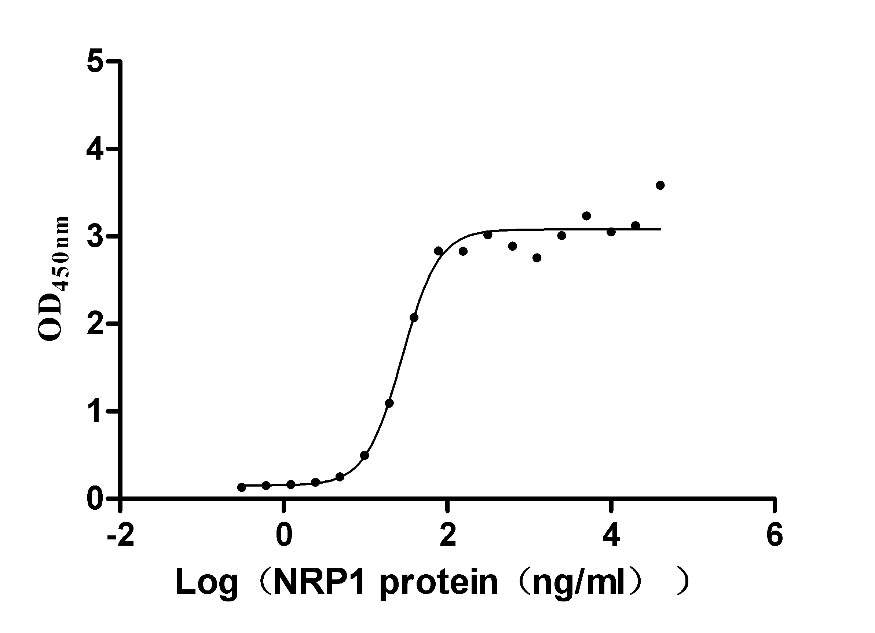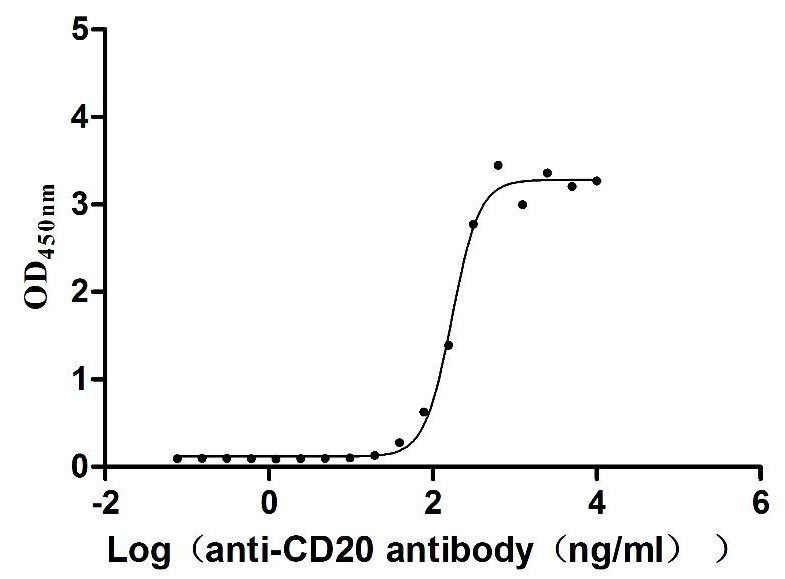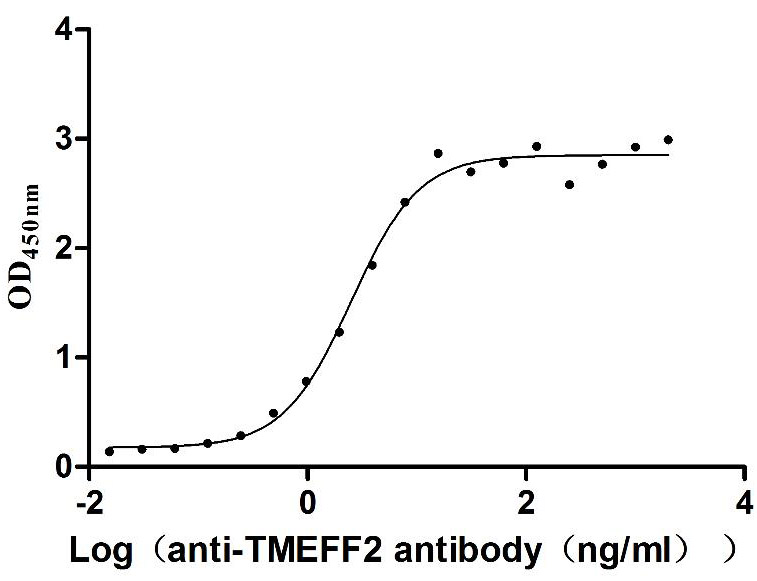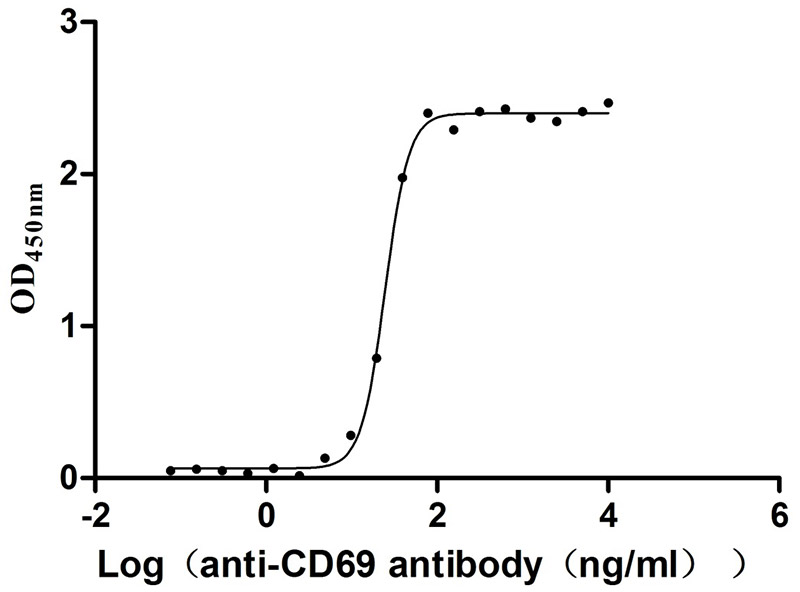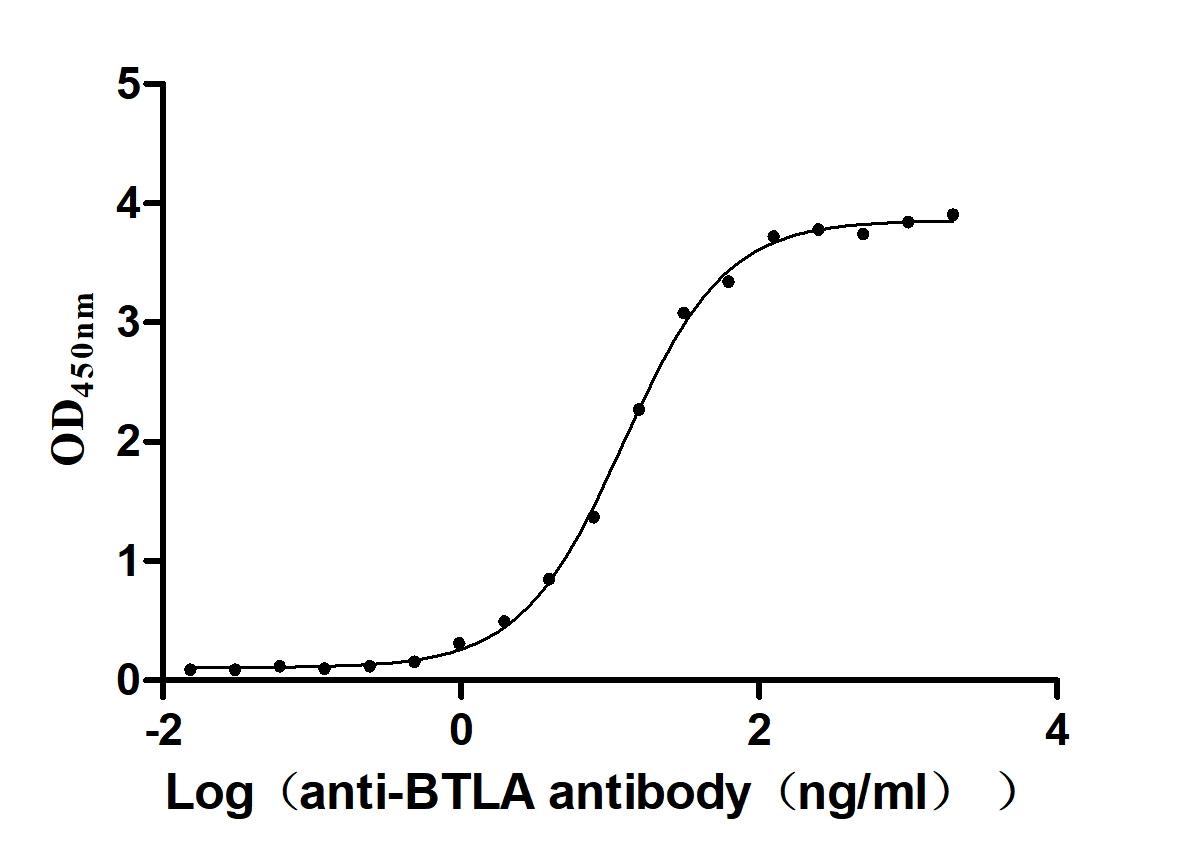Recombinant Human C-C motif chemokine 26 protein (CCL26)
In Stock产品详情
-
纯度:>97% as determined by SDS-PAGE.
-
内毒素:Less than 1.0 EU/μg as determined by LAL method.
-
生物活性:Fully biologically active when compared to standard. The biological activity determined by a chemotaxis bioassay using human CCR3 transfected HEK293 cells is in a concentration range of 0.5- 2.0 μg/ml.
-
基因名:
-
Uniprot No.:
-
别名:C-C motif chemokine 26; CC chemokine IMAC; CCL 26; CCL26; CCL26_HUMAN; Chemokine (C C motif) ligand 26; chemokine N1; Eotaxin 3; Eotaxin-3; IMAC; Macrophage inflammatory protein 4-alpha; MIP 4a; MIP 4alpha; MIP-4-alpha; MIP4a; MIP4alpha; SCYA 26; SCYA26; Small inducible cytokine A26; Small inducible cytokine subfamily A (Cys Cys) member 26; Small inducible cytokine subfamily A member 26; Small-inducible cytokine A26; Thymic stroma chemokine 1; Thymic stroma chemokine-1; TSC 1; TSC-1; TSC1
-
种属:Homo sapiens (Human)
-
蛋白长度:Full Length of Mature Protein
-
来源:E.Coli
-
分子量:8.4 kDa
-
表达区域:24-94aa
-
氨基酸序列TRGSDISKTC CFQYSHKPLP WTWVRSYEFT SNSCSQRAVI FTTKRGKKVC THPRKKWVQK YISLLKTPKQ L
-
蛋白标签:Tag-Free
-
产品提供形式:Liquid or Lyophilized powder
Note: We will preferentially ship the format that we have in stock, however, if you have any special requirement for the format, please remark your requirement when placing the order, we will prepare according to your demand. -
缓冲液:0.2 μm filtered PBS, pH 7.4 ,lyophilized
-
储存条件:Store at -20°C/-80°C upon receipt, aliquoting is necessary for mutiple use. Avoid repeated freeze-thaw cycles.
-
保质期:The shelf life is related to many factors, storage state, buffer ingredients, storage temperature and the stability of the protein itself.
Generally, the shelf life of liquid form is 6 months at -20°C/-80°C. The shelf life of lyophilized form is 12 months at -20°C/-80°C. -
货期:5-10 business days
-
Datasheet & COA:Please contact us to get it.
相关产品
靶点详情
-
功能:Chemoattractant for eosinophils and basophils. Acts as a ligand for C-C chemokine receptor CCR3 which triggers Ca(2+) mobilization in eosinophils. Also acts as a ligand for CX3C chemokine receptor CX3CR1, inducing cell chemotaxis.
-
基因功能参考文献:
- Based on the ADEPT study data set, we report that airway mucosal expression of CCL26 was a robust discriminator of type 2 inflammation from healthy nonatopic subjects. Furthermore, airway mucosal CCL26 expression was best identified by using a panel of clinical biomarkers, including Feno values, bEOS counts, and expression of 2 novel markers, sCCL17 and sCCL26 PMID: 28089872
- hypoxia-inducible factors activate the transcription of chemokine ligand 26 in cancer cells to recruit chemokine receptor 1-expressing myeloid-derived suppressor cells to the primary tumor PMID: 27228567
- this study shows that expression of CCL26 is increased in eosinophilic myocarditis patients compared to chronic lymphocytic myocarditis patients PMID: 27621211
- The reduction of circulating levels of MCP-4, eotaxin-3, and MIP-1beta could be one of the mechanisms by which bariatric surgery contributes to the reduction of cardiovascular risk in these patients. PMID: 27300476
- Review: eotaxins (CCL11, CCL24, and CCL26) play key role(s) during symptomatic inflammatory responses raised in response to allergic crisis of allergic asthma and atopic dermatitis PMID: 26861136
- Data show that the interleukins IL-4 and IL-13 are critical factors for the induction of eotaxin-3/CCL26 in the pancreas. PMID: 26418908
- These results show a relation between CCL26 production by IL-13-stimulated bronchial epithelial cells , sputum eosinophil counts, and asthma severity. They also suggest a role for CCL26 in the sustained inflammation observed in patients with severe eosinophilic asthma and reveal CCL26 as a potential target for treating patients with eosinophilic asthma that are refractory PMID: 25936567
- The most potent inhibition of RANTES, eotaxin and eotaxin3 as well as MMP9 activity. PMID: 25323950
- These findings indicate that eotaxin-3 is expressed in Chronic subdural hematoma fluid PMID: 24684589
- these data suggest that CCL26 and CCL24 are likely involved in the pathogenesis of chronic nasal hypereosinophilia, with a complex cooperation and different involvement of the various members of eotaxin family. PMID: 24989688
- CCL11, CCL24, and CCL26 are increased in TB patients; hence, it seems that TB suppresses Th1 and the classic function of macrophages subsequently by inducing the chemokines' expression PMID: 24600981
- these data identify a contributory role for DNA methylation in regulating eotaxin-3 production in human allergic inflammation. PMID: 24323578
- CCL11, CCL24, and CCL26 has a role in the recruitment of extravillous trophoblast into decidual tissue and vessels. PMID: 23477905
- CCL26 is a more effective chemoattractant than CCL11 or CCL24 for eosinophils of asthmatics. All eotaxins induced the eosinophil migration from 0 to 6 h, but CCL26 triggered a second phase of migration between 12 & 18 h. PMID: 23532518
- CCL1, CCL26, and IgE may be associated with pruritus in cutaneous T-cell lymphoma. PMID: 22948508
- elevated expression in the active lesions of ulcerative colitis and Crohn's disease PMID: 23607908
- Oesophageal squamous cells from gastro-oesophageal reflux disease and Eosinophilic oesophagitis patients express similar levels of eotaxin-3 when stimulated by Th2 cytokines, and omeprazole blocks that eotaxin-3 expression. PMID: 22580413
- PPIs, in concentrations achieved in blood with conventional dosing, significantly inhibit IL-4-stimulated eotaxin-3 expression in EoE esophageal cells and block STAT6 binding to the promoter. PMID: 23185525
- Up-regulation of CCL2, CCL26, IL6 and LOXL2 genes in cancer cells are part of the common effects of cancer-associated fibroblasts on hepatocellular carcinoma cells PMID: 22739041
- Phosphodiesterase 4 inhibitors, rolipram and RO-20-1724 have no effect on CCL26 expression in human primary bronchial epithelial cells. PMID: 22946025
- Leukotriene D4 and interleukin-13 cooperate to increase the release of eotaxin-3 by airway epithelial cells PMID: 22952702
- The level of eotaxin expression and inflammatory cell count were measured in the material from nasal brushing in healthy controls and in patients with allergic rhinitis, asthma, and chronic obstructive pulmonary disease. PMID: 22846146
- Data show that that IL-4 signals through the Jak1, 2/Stat6 pathway in keratinocytes to stimulate CCL26 expression and this may provide an explanation for the pathogenesis of atopic dermatitis (AD). PMID: 22226123
- CCL26 but not CCL24 was elevated in bullous pemphigoid lesions. PMID: 21881593
- The expression of AMCase, eotaxin-3, IL-13, and mRNA was significantly higher in patients with CRSwNP than in the control group. PMID: 21493274
- these data link the up-regulation of the eosinophil chemotactic factor CCL26 in bullous pemphigoid to the lesional accumulation of activated eosinophils in the skin. PMID: 21985360
- Serum eotaxin-3 is a sensitive and specific marker for the diagnosis of active Churg-Strauss syndrome suitable for routine clinical practice. PMID: 21266446
- CCL26-directed small-interfering RNA (siRNA) treatments significantly decreased release of CCL5 (RANTES), CCL15 (MIP-1delta), CCL8 (MCP-2), and CCL13 (MCP-4). PMID: 19203252
- Epigenetic regulation of the IL-13-induced human eotaxin-3 gene by CREB-binding protein-mediated histone 3 acetylation. PMID: 21325281
- AMCase and eotaxin-3 may be important mediators in the pathogenesis of nasal polyps. The increased AMCase and eotaxin-3 might lead to nasal polyp formation and growth. PMID: 21303604
- CCL26 is an agonist for CX3CR1 and may play a dual role in allergic diseases by attracting eosinophils via CCR3 and killer lymphocytes and resident monocytes via chemokine receptor CX3CR1. PMID: 20974991
- Serum CCL11 was increased in ulcerative colitis (UC) and less in Crohn's disease (CD), whereas CCL24 and CCL26 were increased only in UC. Colon expression of the CCL's was higher in UC vs. CD, and was induced by Th2 cytokines in colon epithelial cells. PMID: 21077277
- interaction of eotaxins and CCR3 regulates the Th2-dominant tumor environment, which is closely related to the development of cutaneous T-cell lymphoma PMID: 20505746
- The mean gene expression level for CCL11, CCL24, CCL26 was higher in skin changes of atopic dermatitis patients than in uninvolved skin. PMID: 20236835
- data show that IL-4 and pro-inflammatory cytokines such as TNF-alpha, IL-1beta and IFN-gamma regulate CCL26 synthesis in human monocytic cells PMID: 20059579
- promotes lung fibroblast migration PMID: 20143648
- Expression is modulated by cytokines and glucocorticoids. PMID: 12061839
- Pretreatment or co-treatment with each of the eotaxins augmented PMAtate-induced superoxide generation, concentration-dependent degranulation of eosinophil peroxidase, & potentiation of A23187-induced degranulation. PMID: 12192108
- eotaxin-3 inhibits MCP-1-mediated responses, thus acting as a natural antagonist for CCR2, and promotes active movement of monocytes away from a gradient of eotaxin-3 PMID: 12689946
- eotaxin-3 is the first human chemokine that features broadband antagonistic activities; may have a modulatory rather than an inflammatory function;may play an unrecognized role in the polarization of cellular recruitment by attracting Th2 lymphocytes PMID: 15039444
- results suggest that types 1 and 2 IL-4 receptors and nuclear factor-kappaB may have a role in eotaxin-3 production in bronchial epithelial cells PMID: 15521376
- CCL26 is major eotaxin synthesized and released by alveolar epithelial cells and is involved in autoregulation of CCR3 receptors and other eotaxins. This CCL26-CCR3 ligand-receptor system may be an attractive target in therapy of airway inflammation. PMID: 15863444
- results demonstrate that epithelial eotaxin-3 is up-regulated in the context of a T helper 2 mediated inflammatory bowel disease via the signal transducer and activator of transcription 6 PMID: 16084752
- In conclusion, these results suggest that viral airway infection may enhance interleukin-4-induced eotaxin-3 production through upregulation of the interleukin-4 receptor in airway epithelial cells. PMID: 16264039
- association of eotaxin-3 polymorphisms in ulcerative colitis in Korean patients PMID: 16391516
- results implicate eotaxin-3 as a critical effector molecule for eosinophilic esophagitis and provide insight into disease pathogenesis PMID: 16453027
- Contributes to dermal and epidermal eosinophil infiltration in Th2-polarized skin inflammation in which interleukin-4 is produced. PMID: 17073866
- Data suggest atherosclerotic inflammation may be a trigger for sclerosis in calcified stenotic aortic valves through upregulation TGF-beta, VAP-1, MIG and Eotaxin3, which is only partially inhibited by previous statin therapy. PMID: 17490641
- The Th2 cytokine IL-4 preferentially stimulated eotaxin-3 expression. PMID: 17541284
- Determination of eotaxin-3 levels by real-time polymerase chain reaction on paraffinized, formalin-fixed tissue may be a useful test in the differentiation of eosinophilic esophagitis from gastroesophageal reflux disease PMID: 17900656
显示更多
收起更多
-
亚细胞定位:Secreted.
-
蛋白家族:Intercrine beta (chemokine CC) family
-
组织特异性:Ubiquitously expressed at low levels in various tissues including heart and ovary.
-
数据库链接:
HGNC: 10625
OMIM: 604697
KEGG: hsa:10344
STRING: 9606.ENSP00000005180
UniGene: Hs.131342
Most popular with customers
-
Recombinant Human Neuropilin-1 (NRP1) (Active)
Express system: Mammalian cell
Species: Homo sapiens (Human)
-
Recombinant Human Somatostatin receptor type 2 (SSTR2)-VLPs (Active)
Express system: Mammalian cell
Species: Homo sapiens (Human)
-
Recombinant Dog B-lymphocyte antigen CD20 (MS4A1)-VLPs (Active)
Express system: Mammalian cell
Species: Canis lupus familiaris (Dog) (Canis familiaris)
-
Recombinant Human Tomoregulin-2 (TMEFF2), partial (Active)
Express system: Mammalian cell
Species: Homo sapiens (Human)
-
Recombinant Human Early activation antigen CD69 (CD69), partial (Active)
Express system: Mammalian cell
Species: Homo sapiens (Human)
-
Recombinant Human B- and T-lymphocyte attenuator(BTLA), partial (Active)
Express system: Mammalian cell
Species: Homo sapiens (Human)
-
Express system: Mammalian cell
Species: Macaca mulatta (Rhesus macaque)



